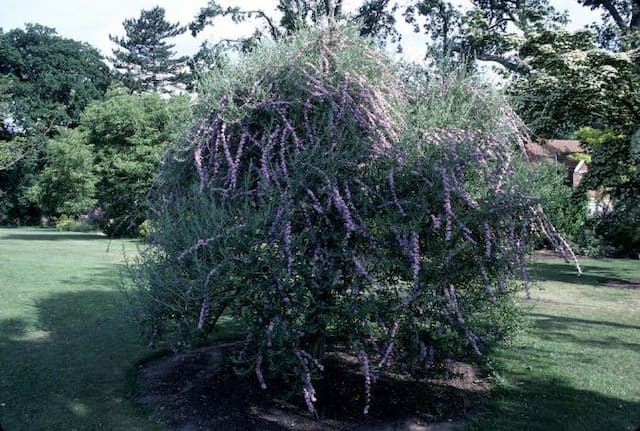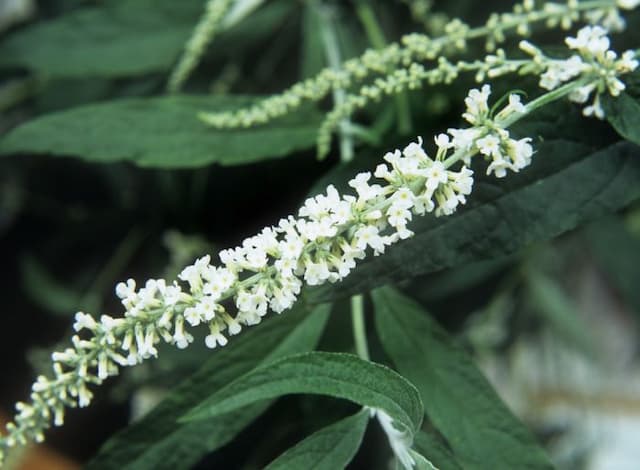Night Phlox Zaluzianskya ovata 'Orange Eye'

ABOUT
The plant called Orange Eye is known for its distinctive and decorative features. It has a dense, bushy growth habit, with green, slightly hairy leaves that provide a lush backdrop for its standout flowers. The leaves are typically oval-shaped with rounded tips and are arranged in opposite pairs along the stems. The flowers of the Orange Eye are particularly eye-catching, blooming mainly during the evening and night. These fragrant blooms are white, with a striking orange to red 'eye' at the center of each flower, giving it a distinctive look that is reminiscent of a sunny-side-up egg. This contrast adds to the plant's ornamental appeal, and when the flowers close during the day, they show off the exterior's pink to purple shades, adding another layer of color to the display. During the nighttime, the Orange Eye emits a sweet, intensely pleasant scent that can fill the air around it, making it an excellent choice for planting in areas where evening fragrance is desired. The flowering period extends through the warmer months, and maintaining the plant with a regular deadheading routine will likely encourage a more extended display of its delightful blooms. Overall, the Orange Eye presents a charming and colorful appearance, contributing to its popularity as a garden plant.
About this plant
 Names
NamesFamily
Scrophulariaceae
Synonyms
Night Phlox, Midnight Candy
Common names
Zaluzianskya ovata 'Orange Eye'.
 Toxicity
ToxicityTo humans
Night Phlox is not well-documented for toxicity to humans, and there is limited information available on its effects if ingested. As with any plant not commonly used for consumption, it is generally advisable to avoid eating parts of the Night Phlox because unknown toxins could potentially cause adverse reactions. If the plant is poisonous, symptoms could range from mild (nausea, vomiting, diarrhea) to severe (organ damage, neurological effects) depending on the amount consumed and individual sensitivity. Always consult medical professionals if ingestion occurs and symptoms develop.
To pets
Night Phlox is not specifically listed as a toxic plant to pets, including cats and dogs. However, the absence of information does not guarantee that the plant is safe. When dealing with unknown toxicity, it's best to err on the side of caution and prevent pets from ingesting the plant. If the Night Phlox is poisonous and a pet ingests it, potential symptoms might include gastrointestinal upset such as vomiting or diarrhea. If you suspect your pet has ingested this plant and is displaying symptoms, contact your veterinarian immediately.
 Characteristics
CharacteristicsLife cycle
Perennials
Foliage type
Evergreen
Color of leaves
Green
Flower color
White
Height
0.5 feet (15 cm)
Spread
0.5 feet (15 cm)
Plant type
Herb
Hardiness zones
7
Native area
South Africa
Benefits
 General Benefits
General Benefits- Attracts Pollinators: The Zaluzianskya ovata 'Orange Eye', commonly known as Night Phlox, is known for its nighttime fragrance which attracts nocturnal pollinators such as moths.
- Low Maintenance: Night Phlox is considered a low-maintenance plant, requiring minimal care once established in the appropriate conditions.
- Drought Tolerant: This plant is relatively drought-tolerant, making it suitable for xeriscaping and water-wise gardens.
- Aesthetic Appeal: With its unique white petals and contrasting orange centers, Night Phlox adds visual interest and beauty to any garden or landscape.
- Fragrance: It releases a sweet fragrance at night, creating a pleasant aromatic environment in outdoor spaces.
- Long Blooming Period: It has a long flowering season, providing an extended display of blooms throughout the summer months.
- Compact Growth: Its compact growth habit makes it ideal for small gardens, containers, and borders where space is limited.
- Deer Resistant: Night Phlox is typically not favored by deer, which can help prevent damage to gardens in areas with deer populations.
 Medical Properties
Medical PropertiesThis plant is not used for medical purposes.
 Air-purifying Qualities
Air-purifying QualitiesThis plant is not specifically known for air purifying qualities.
 Other Uses
Other Uses- Night-scented Ornamental: The plant is often used in evening gardens owing to its strong, sweet fragrance that intensifies at night, providing an aromatic experience.
- Companion Planting: Zaluzianskya ovata 'Orange Eye', commonly known as Night Phlox, can be planted alongside vegetables to attract pollinators for improved yield.
- Education and Research: Night Phlox serves as a subject for study on scent release mechanisms in plants and pollinator attraction strategies.
- Bioindicator: It can potentially serve as a bioindicator for a specific microclimate due to its growth preferences, aiding gardeners in selecting the right plants for their garden environment.
- Photography and Art: Due to its distinctive blooms, Night Phlox is a popular subject for botanical artists and photographers, especially for capturing its evening-opening flowers.
- Container Gardening: This compact plant is ideal for containers, providing a portable fragrance source or a living centerpiece for outdoor dining areas.
- Therapeutic Horticulture: Night Phlox is used in therapeutic garden settings for its sensory qualities, which could contribute to the healing and well-being of people engaging with the garden.
- Eco-Friendly Gardening: Being drought-resistant, Night Phlox is suitable for xeriscaping, thus helping in water conservation efforts.
- Decorative Pressed Flowers: The flowers of Night Phlox can be pressed and used in crafts for making bookmarks, greeting cards, or in scrapbooking.
- Culinary Garnish: Edible varieties of the Night Phlox flowers can be used as a garnish to add a unique aesthetic to dishes, though this specific variety may not be edible and should be researched prior to any culinary use.
Interesting Facts
 Feng Shui
Feng ShuiThe plant named Night Phlox is not used in Feng Shui practice.
 Zodiac Sign Compitability
Zodiac Sign CompitabilityThe plant named Night Phlox is not used in astrology practice.
 Plant Symbolism
Plant Symbolism- Night-Time Charm: Zaluzianskya ovata 'Orange Eye', commonly known as Night Phlox, releases its fragrance after sunset, representing the allure and mysteries of the evening.
- Intimacy: The close-knit petals that open only in the dark evoke feelings of privacy and personal moments shielded from the daylight's prying eyes.
- Balance: The contrast of the white petals with the bright orange center symbolizes harmony and balance in life's dualities.
- New Beginnings: The plant's behavior of closing during the day and opening at night signifies a fresh start or a second chance as each evening brings a new experience.
- Endurance: Night Phlox's hardy nature and ability to flourish in various conditions symbolize resilience and adaptability.
 Water
WaterThe Night Phlox should be watered deeply to ensure the soil is moist but not waterlogged, then allowing the top inch of soil to dry out between waterings. In warmer seasons, this might translate to watering approximately every 7 to 10 days, using about 1 to 2 gallons depending on the size of the plant and the environmental conditions. During winter or cooler months, reduce watering frequency to every 2 to 3 weeks. It’s crucial to avoid overwatering, as this can lead to root rot. Always use a watering can or hose with a gentle flow to avoid disturbing the soil too much around the plant.
 Light
LightNight Phlox thrives best in full sunlight to partial shade conditions. A location that receives at least 6 to 8 hours of direct sunlight daily is ideal. If grown indoors, a south-facing window can be a good spot, providing sufficient light without scorching the plant. However, in extremely hot climates, some afternoon shade can help prevent the leaves from sunburn.
 Temperature
TemperatureNight Phlox prefers moderate temperatures and can generally tolerate conditions between 50°F and 80°F. It can survive minimum temperatures down to about 30°F, but frost can be detrimental to the plant. Ideal growth is usually seen when daytime temperatures hover around 60°F to 70°F. Night Phlox may require protection or movement indoors if temperatures drop significantly below the ideal range.
 Pruning
PruningPrune Night Phlox to maintain its shape and to encourage bushier growth. Deadheading spent blooms can promote further flowering. The best time to prune for shaping is in early spring before new growth starts. Pruning should be done sparingly and not more than once or twice a year, as over-pruning can harm the plant's natural shape and flower production.
 Cleaning
CleaningAs needed
 Soil
SoilNight Phlox requires well-draining soil with a peat-based mix, incorporating perlite and sand for aeration. The ideal pH for this plant is slightly acidic to neutral, around 6.0 to 7.0.
 Repotting
RepottingNight Phlox should be repotted every 1-2 years, or when it has outgrown its current pot, to ensure healthy growth and adequate space for root development.
 Humidity & Misting
Humidity & MistingNight Phlox prefers moderate humidity levels, typically between 40-50%, to thrive and maintain healthy foliage.
 Suitable locations
Suitable locationsIndoor
Place Night Phlox in bright, indirect light and ensure good air circulation.
Outdoor
Plant Night Phlox in a sunny spot with partial shade and shelter from wind.
Hardiness zone
7-10 USDA
 Life cycle
Life cycleNight Phlox 'Orange Eye', like most perennials, begins its life cycle as a seed that germinates in favorable conditions—usually in spring or early summer. Once the seed sprouts, the seedling emerges and establishes itself, growing into a small plant with characteristic foliage. As the plant matures, it develops a robust root system and foliage, entering a vegetative state where it focuses on growth. When the plant reaches maturity, which typically takes several weeks to months, it produces distinctive fragrant flowers, characterized by their white petals with an orange center, that open at night and close during the day. After pollination, which is often aided by moths and other nocturnal pollinators, the flowers produce seeds, completing the reproductive stage. Finally, the plant may enter a period of dormancy during the colder months before reemerging in the subsequent growing season.
 Propogation
PropogationPropogation time
Spring to Summer
The most popular method of propagating Night Phlox or Zaluzianskya ovata 'Orange Eye' is through seed. Start by sowing seeds indoors about 8 weeks before the last expected frost. Lightly press the seeds into a well-draining seed starting mix, ensuring they are not completely covered as they require light to germinate. Keep the soil moist but not waterlogged, at a temperature of approximately 70°F (21°C) until germination, which generally occurs in 14-21 days. Once seedlings emerge and grow strong enough, they can be hardened off and transplanted outdoors after the danger of frost has passed, spacing them about 12 inches (30 centimeters) apart to accommodate their growth.
![Butterfly bush [Buzz Magenta]](/_next/image?url=https%3A%2F%2Fplants-admin.emdemapps.com%2Fimages%2Fplants%2F%2Fimages%2F604b58e34126b.png&w=640&q=75)
![Butterfly bush [Marbled White]](/_next/image?url=https%3A%2F%2Fplants-admin.emdemapps.com%2Fimages%2Fplants%2F%2Fimages%2F604b63353832a.png&w=640&q=75)
![Butterfly bush [Peacock]](/_next/image?url=https%3A%2F%2Fplants-admin.emdemapps.com%2Fimages%2Fplants%2F%2Fimages%2F604b634800554.png&w=640&q=75)





